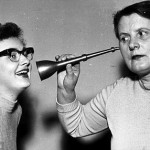 In discussion of trigger warnings (particularly when requested by college students), I’ve seen a fair amount of think pieces suggest that this is more evidence that young’uns have gone soft. It’s not quite “When I was your age, I walked uphill both ways, five miles, through a sea of graphically dismembered bodies marked with racial slurs, and it made me stronger!” but there’s a certain family resemblance. There just seems to be a suspicion that attaches itself to people complaining that the status quo is painful — if we can endure it, why can’t they?
In discussion of trigger warnings (particularly when requested by college students), I’ve seen a fair amount of think pieces suggest that this is more evidence that young’uns have gone soft. It’s not quite “When I was your age, I walked uphill both ways, five miles, through a sea of graphically dismembered bodies marked with racial slurs, and it made me stronger!” but there’s a certain family resemblance. There just seems to be a suspicion that attaches itself to people complaining that the status quo is painful — if we can endure it, why can’t they?
Acting in Solidarity for Others
There are two important rejoinders that have occurred to me. First of all, some people are agitating on behalf of others, who are in more-than-usual danger. When I work at a CFAR workshop, my voice is usually the loudest one warning people not to transfer serving utensils between platters, even though I’m not allergic to anything. I just have excellent projection, so I’m good at getting everyone’s attention, and my making the announcement preserves the anonymity of the people with life-threatening allergies, so that vulnerability to shellfish is not the thing everyone else learns about them first.
Trigger warnings, especially as used on feminist sites, were primarily intended for the safety of people with PTSD or at risk of panic attacks. You don’t want to be scrolling through your feedly and run across a rape-related case that’s so similar to your own rape that it gives you flashbacks and has you hyperventilating at work any more than I want to be reading my disease-related blogs and seeing (without warning) an image so graphic and disgusting that I retch (or worse) at my desk.
There’s plenty of patience for any accommodation I need (the NYT blacks out graphic news photos unless you click to reveal them, epidemiology blogs stash graphic images under a cut), even though my danger is smaller. Trigger warnings can probably only be reasonably accommodated so far down the long tail (just as people frequently mark “contains nuts” by default, but rely on those who are allergic to strawberries to speak up and ask), but we could probably go farther down the tail than we do at present without too many ill effects (or we could try, and then pull back as needed).
Here, the major things that’s changed is our ability to hear and help people farther down the tail. The internet has catalyzed the speech equivalent of foundations for orphan diseases.
The world changed, not the people
But the other useful reply to “We never needed trigger warnings before” might just be, “Huh, I wonder if anything’s changed?”
The correct response to repetitive strain injury would not have been “Eh, we never needed ergonomics when I was young” but a bit of curiosity about how people’s work setups had changes and whether there were useful interventions. Looking into carpal tunnel and other peculiarly modern problems helped us identify some of the downsides of recent innovations and patch them moderately well.
Just as we now all spend much more time in front of a computer than before, we spend much more time reading and watching superstimulatory things online than previously. In a recent New Yorker review of Fargo, Emily Nussbaum expressed some discomfort with the antihero arms race of television, quoting critic James Poniewozik, “TV’s not a chili-pepper-eating contest.” There’s more viciousness to consume, if we choose to, and it’s a lot more vivid than it’s always been.
Additionally, for some people (disproportionately women), they don’t face all this intensity as a consumer, but as a target. The ease of communicating over twitter and email (and physical contact, for people who don’t deliberately hide their address) puts plenty of writers at risk. I’ve had blogs disappear from my feedreader because they received so many threats that it didn’t seem safe for the author to keep writing. A friend of mine was drawn, over the past week, into a twitter fight than involved plenty of strangers casting aspersions on her character and talking unpleasantly graphically about what she would be like to have sex with.
The prevalence of this kind of behavior means that some people are enduring horrendous harassment daily, but, also, for many others, it’s likely enough to cause day to day tsuris or prompt precautions. I’m low profile enough to have never been harassed online in this way, but my escape feels more arbitrary than the result of my own tactics, which leaves future harassment out of my control.
I don’t know whether living in a world where rape jokes and threats of violence are taken for granted in non-curated comment sections has anything to do with a new focus on trigger warnings, but it does seem like it could fray people’s patience and resilience, to the point where a provocation our parents might have let passed really is pretty hard to bear.
Thinking about whether anything has changed, and whether it should be addressed gives us the chance to stumble on solutions that don’t just help the most vulnerable (people with panic attacks, who need trigger warnings), but might reduce unpleasantness in day to day life that isn’t debilitating to most people, but isn’t helpful to anyone.
This is sometimes referred to as the curb-cut effect, where an accommodation for the disabled (curving the curb down to meet the street, for ease of wheelchair use), turns out to be a helpful change for a broader class of people than the one it was intended for (bikers, parents with strollers, etc).
The push for trigger warnings is still in its early, exploratory stages, which is a great time to ask questions about what kind of harm is being prevented and to keep brainstorming the best ways to address it. But to start, it helps to treat “Why are you all so sensitive?” as an honest, curious question, rather than a dismissal.











